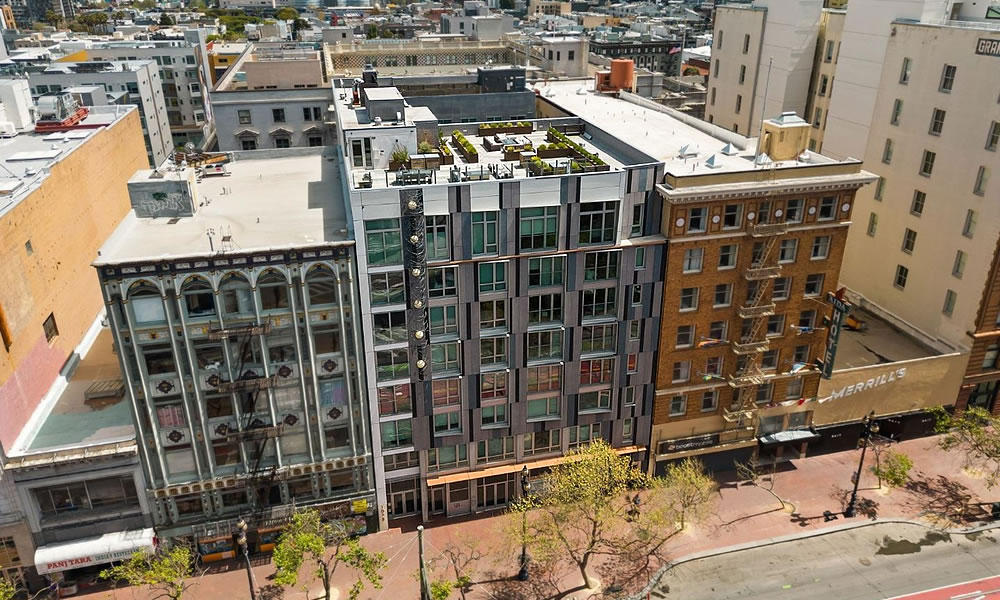Featuring two bedrooms, two baths and two parking spots in the boutique Mid-Market building’s garage, the 870-square-foot unit #513 at 1075 Market Street (a.k.a. Stage 1075) sold for $1.25 million in May of 2019, establishing a neighborhood comp at $1,437 per square foot.
Three months ago the contemporary unit, which “checks all the boxes,” returned to the market priced at only $1.025 million, a sale at which would have represented an 18 percent drop in value from the second quarter of 2019 on an apples-to-apples basis, despite the fact that the frequently misreported index for “San Francisco” condo values is “still up” over the same period of time.
Dropped to $949,000 after a week on the market and then relisted for $899,000 in September, the list price for 1075 Market Street #513 has just been reduced to $769,000, with an interim reduction to $849,000 last month. As such, an “at asking!” sale for 1075 Market #513 would now represent a net 38 percent drop in value for the two-bedroom unit from the second quarter of 2019.
If you think you know the market for contemporary Mid-Market condos and other units which benefited from the 2019-era comp(s), here’s another chance to tell.







Love this quote on the listing (and I mock as an SF bull): “Mid-Market is truly the heart of San Francisco with its vibrant & limitless offerings.”
In fifty years, once the count of SRO’s is greatly diminished, three construction booms are in the books, and SF is tougher on crime, I think the realtor might be right. But not now, and not anytime soon.
It’s a soulless condo in one of the worst spots. I only hope the original buyer was an out of town investor who bought it sight unseen.
My favorite part is that it comes with not 1, but 2 parking spots, located directly above BART and Muni, in a walkable downtown area. Also lost me at $924/month in HOAs.
Market b/w 6th and 7th is technically walkable, you just might not walk back. You’re right, two cars is crazy, you really need a tank to get out of that neighborhood.
If that’s an accurate summary of prevailing sentiment, then this moment is the perfect time to be selling this condominium and conducting open houses to drum up demand for it, ’cause the area was and is being cleared out of homeless people, reportedly in preparation for the the Asia-Pacific Economic Cooperation conference. Well played, Sequoia Real Estate Brokerage!
Perhaps Dixon Hill can reach out to the clients in Asia that he has, and check to see if they’re interested in something in the sub- $800k price segment.
I may be mistaken but didn’t you cite the performance of Redfin stock earlier this year as an indicator that the market was recovering? Might want to refresh your stock screen…
I believe the exchange in question went like this:
soccermom indicated that “it’s probably a better time to buy RDFN than a house.”
Then you, SanFranSeeYa, said: “yes it’s 94% from it’s all time highs but there is still 100% downside”
I followed that by mentioning that stock was up substantially year to date, while challenging the notion that the stock was going to go to zero, and I also said that I personally wouldn’t buy it right then.
I still think both of those are true: that I wouldn’t buy the stock now (or then, obviously), but it probably still won’t go to zero.
I don’t have an opinion about whether or not that stock’s price is a good indicator of the overall housing market’s future returns.
That’s not gonna work – the area is also largely clear of people, autos, and transit.
Maybe it sells at $700,000. who knows? Interesting point is that this is WAY below its cost of production, meaning this areas,and probably a very wide zone around, it is not viable for new housing development. So, have to ask how the City will ever make it mandated goals for new housing production per the Housing Element. Dont see that as possible.
Zero city fees, an affordable housing percentage of 0%, and not using union labor would be a start.
Of course, this is not even within the realm of reasonable, and if the local development community is on some kind of Ayn Randian John Galt-ian “strike” against San Francisco and waiting to get all this before they start building, then they will get what they deserve in a few years: a ballot initiative dissolving The State HCD and another one that rolls back SB 4 and 423, among other recent excesses foisted upon the public by state Sen. Scott Wiener (who will be out of office by then).
AB 2011 already lowered labor standards in the State, if real estate capitalists won’t actually build housing under all the recent legislation kow towing to them, then local governments should do so without them. Bring back redevelopment agencies.
I could see the percentage requirement being dropped down to 5-10%, but I agree, it’s not within the realm of reasonable.
At some point, the falling prices obviate the need for lottery condos, no?
No, BobN. For a MOHCD Below Market Rate homeownership lottery, the Mayor’s Office of Housing checks the last 3 years of an entrant’s Federal Income Tax Returns and verifies housing lottery entrants for eligibility. They also check, among other things, all assets, such as bank accounts, savings bonds, stocks, and investments and etc. that are owned or jointly owned by the applicant or any member of their household. This eliminates trustafarians and also real-world Jesse Pinkman types.
If we didn’t have BMR and/or lottery condos and just relied on the all-singing, all dancing free market as you suggest, San Franciscans on lower rungs of the income ladder seeking a more affordable home would be bidding against certain PRC government officials looking to squirrel their funds derived from bribery, kickbacks, and misappropriation of public funds away from China and the prying eyes of Chairman Xi Jinping’s ongoing anti-corruption campaigns. San Franciscans would also be up against private equity firms, real estate investment trusts and penny ante mom and pop landlords looking for “deals” which, ceteris paribus, would tend to increase the price of properties past the level of units available via the lottery.
There is a studio on the same floor of this building that has been offered for sale at $303,265 for closing in on eleven months on market, which is a Below Market Rate (BMR) housing opportunity, without a lottery.
The supposed objective of the mandate, shortsighted as it is due to a fundamental misunderstanding of the economics of shelter, is to provide affordable housing for the “workforce” (i.e.,blue collar workers providing essential goods and services who are otherwise priced out of boomtown). 0% affordable housing would raise property values and ensure more gentrification, thus increasing workforce shelter costs and providing fuel for more rounds of inefficiency-inducing speculation.
I’d love to snap my finger and flood the city of SF with 100,000 units (likely white boxes but it will do) so we had affordable workforce housing due to supply and demand. Alternatively, I’d love for the government to actually take a stab at non-profit public housing again, and do it properly, to provide workforce housing.
Somebody correct me if I’m wrong: The State mandate raises a (perverse?) incentive to maximize units-built, i.e. studios and 1BRs, where we already see abundance/oversupply. Meanwhile, workforce family housing remains in short supply. Not that I’d expect much will be built anyhow, given the current economies of doing so.
percentage wise this could be the biggest loser we’ve seen so far.
Not even close.
Between 6th and 7th? Location not worth it.
At first glance, sure. But you get those precious two parking spots in the garage, which is an amenity you’d likely pay much more for in other central areas of The City.
It’s a tradeoff. Having your car at hand means you won’t have to be as exposed to the urban grit and decay as someone walking.
Do HOA rules permit owner to lease out 2nd parking space?
I’d guess only to another resident of the building.
With regard to “other units which benefited from the 2019-era comps”, here’s my entry. Consider a 423 ft.² studio in this same neighborhood, “located close to shops, transportation & tech companies”, which sold for $590,000 in late Feb of 2019, establishing a neighborhood comp for lower-floor studio units at $1,395 per ft.². Less than fifteen months later (!), the apartment returned to the market priced at $599,000, a sale at which would have represented a modest 1.5 percent increase in value from the first quarter of 2019.
Unfortunately, it appears (to my layman’s eyes) not have sold at that price because it was de-listed from the MLS after a month and subsequently placed on the rental market in the Fall of 2021 for $2,050 per month. Perhaps the owner managed to get it rented later that quarter, for the entirety of 2022 and further was able to refinance the unit as a commercial property at all time low fixed mortgage rates before The Fed began hiking in March of that year.
It was re-listed for sale in the first quarter of this year at $529k, so maybe the owner’s a candidate real estate “genius” that Jimmy was referring to last year.
The seller and their agent then decided to put on a clinic on how to chase the market down. The asking price was changed to $509k in April, then $489.9k in June, $469k in July, $455k in August, landing at a rock bottom $439.9k in September of 2023. As such, an “at asking!” sale for the apartment would now represent a nominal 25.4 percent decrease in value for the studio unit compared to the first quarter of 2019, or about $1,040 per ft.² compared to the above-described unit 513 (which again, is a 2 bedroom, 2 bathroom unit, and so shouldn’t it command a premium?) at $884 per ft.².
I’m not a realtor. I’m making that comparison on a per square ft. basis because the apartment I’m talking about is unit 211 in the same building (Stage 1075 is an 8-story mid-rise, so the potential premium for a penthouse with unit 513 isn’t in consideration here).
A further price reduction corresponding to the level implied by the current asking price of unit 513 highlighted in the above post would be to $373.9k, or almost a 37 percent decrease in value for the studio unit compared to the sale in 2019, again in nominal terms. If unit 211 closes during the next sixty days, I think the seller is going to “eat it”.
Well, it didn’t close in the sixty days following the above comment, but the seller did a bit better than I projected and it only took another several days after that time frame to get the unit sold. Unit 211 closed last month at this time, for $400k or $946 per ft.², which was marginally above the asking price of $399k landed on in mid-November of 2023.
$695K.
If the seller gets full asking price of $695k, after a 6% real estate commission that is a nominal 48% loss. Unfortunately the real loss is greater:
According to the U.S. Bureau of Labor Statistics CPI Inflation Calculator $ 1,250,000.00 in June 2019 has the same buying power as $1,505,101.64 in January 2024. So the real loss is closer to 1,250,000 – 695,000*0.94 – 255,101.64 or $908,400 (~73%). That assumes you were able to take $1,250,000 and invest to meet or beat recent inflation rates while at the same time not needing shelter in that particular area. There could be an argument that the real loss is only applicable to a typical down payment of 20-25%. Also we are setting aside the cost of HOAs and property taxes.
UPDATE: Having been relisted anew at a further reduced list price of $695,000 in January, an “at asking” sale at which would represent a 44 percent drop in value for the two-bedroom unit, 1075 Market Street #513 is now in contract.
The seller did not wind up getting the full $695,000 asking price. 1075 Market St. Unit 513 finally sold for $675,000 this past April, a mere 81 days on market after the January 2024 relisting mentioned in the comment above and 2.8 percent under asking. That closing price represented an equity-evaporating 46 percent decrease (a nominal $575,000) from the previous sale almost five years earlier.
I’m guessing that the buyer’s a candidate real estate “genius”, because they then put the 2 bedroom, 2 bathroom, 2-car deeded parking space condo on the rental market two months afterwards asking $3,950. They followed that up by lowing the asking rent to $3,700 later the same month.
I hope the buyer managed to get a good mortgage interest rate if they financed the purchase. At prevailing 6.88 percent 30-year fixed loan rates at the time, assuming a 20 percent down payment and 4 percent closing costs, the payment on the bargain closing price including the $1027 HOA Fee, Principal & interest, Property tax, and Home insurance adds up to north of $5,400 per month. That is over 68 percent more than what Zillow Rentals advertised the asking rent for the unit was ($3,200) in August. As of this writing, the same site reports that there are 7 available units in the building available for lease.
Nice summary. Stage 1075 is the definition of a money pit! Rough.